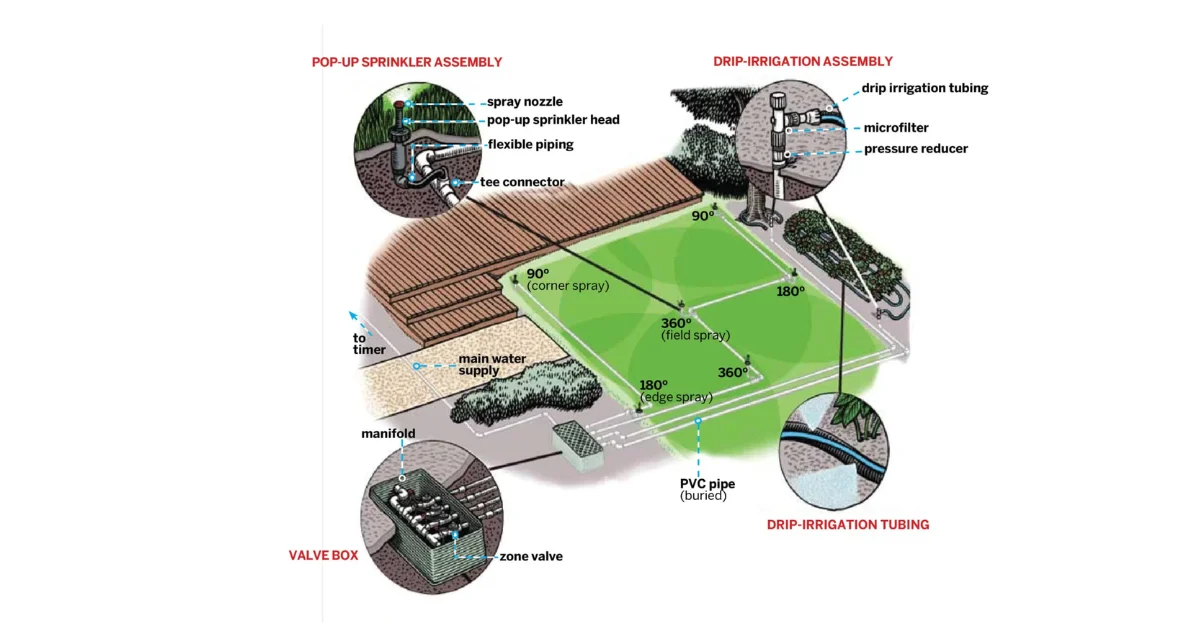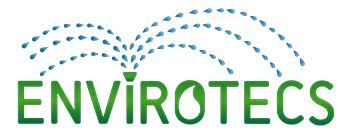
A consistent and efficient watering is must to maintain a healthy lawn or garden. It is especially needed in areas with irregular rainfall or hot climates. If you’ve ever struggled with overwatering, underwatering, or even the time-consuming task of manually watering your plants, an irrigation system is the solution you need.
You must install an irrigation system if you want to increase water efficiency, reduce utility bills, and improve the overall appearance of your property. It also ensures that your lawn and plants are consistently hydrated, even when you’re away, making it an investment in both your time and property’s value.
At Wise Water Works, we specialize in providing expert irrigation solutions tailored to your unique landscape. Our systems are designed for efficiency, saving water and reducing costs.
With years of experience, we offer installation and maintenance services that ensure your irrigation system works seamlessly year-round
What Is An Irrigation System?
An irrigation system is a method used to supply water to plants, crops, or landscapes in a controlled and efficient manner. It is designed to complement or replace natural rainfall, ensuring that plants receive the necessary hydration even during dry periods.
These systems use various components, including pipes, pumps, sprinklers, and timers, to distribute water evenly across the area being irrigated.
By providing a consistent water supply, an irrigation system helps promote healthier plant growth, increases agricultural productivity, and conserves water by minimizing waste.
Top 7 Reason Why Installing An Irrigation System Is A Worth It Investment
1. Increased Home Value
Installing an irrigation system can significantly enhance your property’s value. A well-maintained landscape with a professional irrigation system improves curb appeal, making your home more attractive to potential buyers.
Studies show that homes with lush, well-watered lawns can increase property value by up to 15%.
A reliable irrigation system assures prospective buyers that the lawn and landscaping will be easy to maintain. Additionally, a right irrigation system can appeal to eco-conscious buyers by offering water conservation benefits, further boosting its desirability.
2. Protection Against Drought Conditions
In Texas, where droughts are frequent, an irrigation system is crucial for maintaining a healthy lawn and garden. With inconsistent rainfall and extended dry periods, irrigation systems ensure your landscape gets consistent hydration.
During Texas’ hot summer months, these systems protect plants from heat stress and prevent wilting. By using efficient watering methods, irrigation minimizes water waste while providing the necessary moisture for optimal plant growth. This is especially important for homeowners in areas like Dallas, Austin, and Houston, where water conservation is key.
3. Improved Lawn and Landscaping Quality
An irrigation system ensures consistent watering, which is essential for maintaining a healthy, vibrant lawn and garden. By delivering the right amount of water at the right times, it helps avoid common issues like brown patches, dry spots, and uneven growth.
The system promotes deep root growth, making plants stronger and more resilient. With even hydration, your lawn will stay lush and green, and your flowers, shrubs, and trees will thrive. This enhanced aesthetic quality boosts the overall appearance of your property.
4. Prevention of Disease Spread
An irrigation system plays a vital role in preventing the spread of diseases in your lawn and garden. Overwatering, often caused by manual watering methods, can create conditions that encourage fungal growth, root rot, and other plant diseases.
By providing consistent and controlled watering, irrigation systems avoid waterlogging and allow the soil to dry appropriately between watering cycles. This reduces excess moisture and helps prevent common waterborne diseases.
5. Water Conservation
An irrigation system ensures that water is applied efficiently, reducing waste and promoting conservation. By using smart controllers and sensors, the system adjusts water usage based on weather conditions, preventing overwatering.
Drip irrigation, for example, delivers water directly to plant roots, minimizing evaporation and runoff. This targeted approach allows you to maintain a lush landscape while using less water, which is especially beneficial in water-scarce areas like Texas..
6. Time Savings
Installing an irrigation system saves you time by eliminating the need for manual watering. With an automated system, you don’t have to worry about watering your lawn every day, especially during the early morning hours when it’s ideal for plant health.
Whether you’re away on vacation or simply busy with other tasks, your irrigation system will keep your landscape hydrated on a set schedule. This time-saving convenience frees you up for more important activities while ensuring that your lawn and garden receive consistent care.
7. Prevents Soil Erosion
Irrigation systems help prevent soil erosion by providing controlled and even water distribution. Overwatering can cause runoff, which leads to the loss of topsoil and valuable nutrients, making it harder for plants to grow.
With a properly installed irrigation system, water is delivered directly to the roots, reducing surface runoff and allowing it to absorb slowly into the soil.
This prevents soil erosion, stabilizes the landscape, and protects plant roots. A well-maintained irrigation system ensures that your soil remains intact, preserving its fertility and keeping your lawn and garden healthy.
Different Types of Irrigation Systems to Consider for Your Landscape
1. Sprinkler Systems
Sprinkler systems distribute water evenly, mimicking rainfall. They cover large areas and are ideal for lawns, offering adjustable heads for efficient, customizable watering.
2. Drip Irrigation Systems
Drip irrigation targets plant roots directly, reducing water waste. It’s perfect for gardens, flower beds, and trees, providing consistent moisture where it’s needed most.
3. Soaker Hoses
Soaker hoses release water along their length, soaking the soil evenly. They’re ideal for smaller areas like garden beds or rows of plants, ensuring efficient hydration.
4. Surface Irrigation
Surface irrigation uses water flowing over soil to hydrate plants. It’s often used in agriculture but can be less efficient due to water runoff, requiring careful planning.
5. Subsurface Irrigation
Subsurface irrigation delivers water beneath the soil surface, minimizing evaporation. It’s ideal for deep-rooted plants and large areas, ensuring moisture directly reaches the roots.
How Much Does It Cost To Install An Irrigation System
The cost to install an irrigation system depends on factors such as yard size, type of system, and local conditions. On average, installing an automatic in-ground sprinkler system costs between $0.28 and $0.47 per square foot.
For a quarter-acre yard, this typically amounts to $3,049 to $5,118. Some contractors charge per watering zone, with prices ranging from $580 to $1,000 per zone, and most quarter-acre yards need 4 to 7 zones.
Larger yards or more complex systems can cost significantly more, with one-acre properties ranging from $10,213 to $20,473. Additional expenses for permits, labor, and system features like sensors may also apply.
Things To Consider For Installing An Irrigation System
Several key factors will ensure you get the most efficient, cost-effective, and long-lasting solution for your landscape when considering an irrigation system. Here’s what you should keep in mind:
1. Yard Size and Layout
The size and shape of your landscape directly affect how the system is designed. If you have a large or oddly shaped yard, you may need multiple zones or advanced systems like drip irrigation.
For sloped areas or tricky layouts, specialized sprinklers may be necessary to ensure consistent water coverage, helping you avoid water waste.
2. Water Source and Pressure
Your water source and pressure are crucial. If your home’s water pressure is low, you may need a booster pump to ensure that the system works properly. Without a steady water supply, the system won’t perform efficiently, leading to uneven watering and potential issues in large areas.
3. Soil Type
Your soil type has a big impact on how water is absorbed. If your soil drains quickly (like sandy soil), you’ll need more frequent watering. Conversely, clay soil holds water longer, so the best irrigation system will need to be adjusted accordingly. By matching the system to your soil, you can avoid wasting water and ensure your plants get exactly what they need.
4. Plant Watering Needs
Not all plants require the same amount of water. Grouping plants with similar water needs into separate zones will ensure that you water them efficiently. For example, shrubs and garden beds may benefit from a drip irrigation system, while a lawn will do well with sprinklers. Make sure your system is tailored to your plants’ specific needs for optimal growth.
5. Climate and Local Weather
Consider the weather patterns in your area. In regions with frequent rainfall, rain sensors can help prevent overwatering. If you live in a dry climate or experience extended droughts, you’ll need a more robust system to maintain your landscape. Adjusting your system to your local climate will save water and keep your yard thriving.
6. System Maintenance and Longevity
Think about how easy the system will be to maintain. Some systems require more frequent checks and repairs, especially if they have underground piping. You’ll want a system that can be easily serviced to prevent clogs or leaks and ensure it performs at its best for years.
In Closing
Installing an irrigation system can greatly improve your landscape’s health, save time, and reduce water waste. It ensures your plants are consistently hydrated, even during dry spells, while lowering water bills. An irrigation system offers long-term benefits and enhanced property value for residential or commercial properties.
Ready to upgrade your landscape with a reliable irrigation system? Contact Wise Water Works today for a tailored solution that meets your needs and helps you save water and money.
Frequently Asked Questions
Question: How long does it take to install an irrigation system?
Answer: The installation time depends on your property’s size and the system’s complexity. An average residential yard can take anywhere from 1 to 3 days. Larger properties or more intricate systems may take longer. Professional installation ensures everything is set up correctly and efficiently, avoiding delays.
Question: How much maintenance does an irrigation system require?
Answer: Irrigation systems require regular maintenance to ensure optimal performance. This includes checking for clogs, inspecting sprinkler heads, and testing controllers. An annual inspection, particularly before the start of the watering season, is recommended to ensure everything is working properly.
Question: Can I install an irrigation system myself?
Answer: While installing a basic system yourself is possible, hiring a professional is often better. Proper installation is crucial for efficiency, as mistakes in design or setup can lead to water waste or coverage issues. A professional can design a system tailored to your landscape’s unique needs.
Question: Will an irrigation system increase my water bill?
Answer: An irrigation system is designed to be more efficient than manual watering, saving you money in the long run. By using a smart controller and sensors, you can reduce water waste and lower your water bill. The savings will often outweigh the initial installation costs over time.
